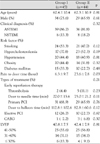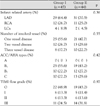Abstract
Background and Objectives
The left ventricular ejection fraction (LVEF) is known to be a significant prognostic factor for patients with acute myocardial infarction (AMI). The aim of this study was to investigate clinical or therapeutic factors associated with the recovery of a low LVEF for patients with AMI.
Subjects and Methods
From January to December 2004, we enrolled 89 patients (mean age: 62.5±10.6 years, 43 males and 26 females) with AMI and who had a LVEF less than 50%. Forty five patients whose LVEF improved more than 10% were classified as group I (mean age: 62.4±10.4 years, 34 males and 11 females) and 44 patients whose LVEF was not changed or decreased were classified as group II (mean age: 62.3±10.9 years, 29 males and 15 females). The clinical variables, including risk factors and the pain-to-door time, the biochemical markers of myocardial injury, the coronary angiographic findings and the treatment-related variables, were compared between the two groups.
Results
The cardiovascular risk factors were not different between the groups. The location of infarction, the success rate of percutaneous coronary intervention and the coronary angiographic lesion morphologies were not different between the groups. However, the pain-to-door time was significantly shorter in group I than in group II (6.0±9.5 vs 22.4±7.5 hours, respectively, p=0.046). Improved control of risk factors was not associated with the recovery of LV function. The use of beta-blocker, statin, anti-platelet agents, vasodilators and diuretics were not different between the groups. However, the use of angiotensin converting enzyme inhibitor (ACEI) was more common in group I than group II (79.3% vs 47.4%, respectively, p=0.03).
Figures and Tables
References
1. Hyun DW, Kim KS, Synn YC, et al. Clinical characteristics of acute myocardial infarction died during hospitalization. Korean Circ J. 1998. 28:1518–1526.
2. Stevenson RN, Ranjadayalan K, Umachandran V, Timmis AD. Significance of reciprocal ST depression in acute myocardial infarction: a study of 258 patients treated by thrombolysis. Br Heart J. 1993. 69:211–214.
3. Joung BY, Ha JW, Choi DH, et al. Age-related difference in long-term prognosis of acute myocardial infarction in women. Korean Circ J. 2000. 30:1245–1256.
4. Hong YJ, Jeong MH, Park OY, et al. The Long-term clinical outcomes after rescue percutaneous coronary intervention in patients with acute myocardial infarction. J Interv Cardiol. 2003. 16:209–216.
5. Kjoller E, Kober L, Jorgensen S, Torp-Pedersen C. Long-term prognostic importance of hyperkinesia following acute myocardial infarction. Am J Cardiol. 1999. 83:655–659.
6. Kim SY, On YK, Chae IH, et al. Long term survival rate and prognostic factors of acute myocardial infarction in Korea. Korean J Cardiovasc Dis. 2000. 1:56–61.
7. Richards AM, Nicholls MG, Espiner EA, et al. B-type natriuretic peptides and ejection fraction for prognosis after myocardial infarction. Circulation. 2003. 107:2786–2792.
8. Sheiban I, Fragasso G, Rosano GM, et al. Time course and determinants of left ventricular function recovery after primary angioplasty in patients with acute myocardial infarction. J Am Coll Cardiol. 2001. 38:464–471.
9. van't Hof AW, Liem A, Suryapranata H, Hoorntje JC, de Boer MJ, Zijlstra F. Clinical presentation and outcome of patients with early, intermediate and late reperfusion therapy by primary coronary angioplasty for acute myocardial infarction. Eur Heart J. 1998. 19:118–123.
10. Braunwald's Heart Disease: a textbook of cardiovascular medicine. 2005. 7th ed. Philadelphia: Elsevier Saunders;1141–1165.
11. Lim SY, Jeong MH, Bae EH, et al. The clinical significance of elevated troponin in patients with acute coronary syndrome with normal ectrocardiogram. Korean Circ J. 2003. 33:385–392.
12. Cummins RD. The acute coronary syndromes. Textbook of Advanced Cardiac Life Support. 2002. American Heart Association;377–375.
13. Halkin A, Stone GW, Dixon SR, et al. Impact and determinants of left ventricular function in patients undergoing primary percutaneous coronary intervention in acute myocardial infarction. Am J Cardiol. 2005. 96:325–331.
14. Maekawa Y, Anzai T, Yoshikawa T, et al. Prognostic significance of peripheral monocytosis after reperfused acute myocardial infarction: a possible role for left ventricular remodeling. J Am Coll Cardiol. 2002. 39:241–246.
15. Cho J, Park CS, Lee DP. Risk factors affecting the mortality of acute myocardial infarction during the first 24 hour after onset. J Korean Soc Emerg Med. 1999. 10:607–614.
16. Goldenberg I, Matetzky S, Halkin A, et al. Primary angioplasty with routine stenting compared with thrombolytic therapy in elderly patients with acute myocardial infarction. Am Heart J. 2003. 145:862–867.
17. Castelli WP. Cardiovascular disease in women. Am J Obstet Gynecol. 1988. 158:1553–1560.
18. Pfeffer MA, Braunwald E, Moye LA, et al. Effect of captopril on mortality and morbidity in patients with left ventricular dysfunction after myocardial infarction: results of the survival and ventricular enlargement trial. N Engl J Med. 1992. 327:669–677.
19. Ko JS, Joo SY, Jeong MH, et al. Predictive factors for heart failure in patients with unstable angina and acute non-ST elevation myocardial infarction. Korean Circ J. 2004. 34:459–467.
20. Lee HJ, Shin GJ, Cho HK, Park SH. Serum lipid changes during the acute phase of acute myocardial infarction. Ewha Med J. 2000. 23:85–90.
21. Pulleti M, Sunseri L, Curione M, Erba SM, Borgia C. Acute myocardial infarction: sex-related differences in prognosis. Am Heart J. 1984. 108:63–66.
22. Greenland P, Reicher-Reiss H, Goldbourt U, Behar S. In-hospital and 1-year mortality in 1,524 women after myocardial infarction: comparison with 4,315 men. Circulation. 1991. 83:484–491.
23. Robinson K, Conroy RM, Mulcahy R, Hichey N. Risk factors and in-hospital course of first episode of myocardial infarction or acute coronary insufficiency in women. J Am Coll Cardiol. 1988. 11:932–936.
24. Iwakura K, Ito H, Ikushima M, et al. Association between hyperglycemia and the no-reflow phenomenon in patients with acute myocardial infarction. J Am Coll Cardiol. 2003. 41:1–7.
25. Oe K, Shimizu M, Ino H, et al. Effects of gender on the number of diseased vessels and clinical outcome in Japanese patients with acute coronary syndrome. Circ J. 2002. 66:435–440.
26. Sim DS, Jeong MH, Kim W, et al. Long-term clinical benefits of a platelet glycoprotein IIb/IIIa receptor blocker, abciximab (ReoPro), in high-risk diabetic patients undergoing percutaneous coronary intervention. Korean J Intern Med. 2003. 18:129–137.
27. Jeong PH, Lee JY, Yoo BS, et al. Acute myocardial infarction in the young adult. Korean Circ J. 1998. 28:8–12.
28. Iriarte M, Caso R, Murga N, et al. Microvascular angina pectoris in hypertensive patients with left ventricular hypertrophy and diagnostic value of exercise thallium-201 scintigraphy. Am J Cardiol. 1995. 75:335–339.
29. The Acute Infarction Ramipril Efficacy (AIRE) Study Investigators. Effect of ramipril on mortality and morbidity of survivors of acute myocardial infarction with clinical evidence of heart failure. Lancet. 1993. 342:821–828.
30. Hong YJ, Jeong MH, Hyun DW, et al. The prognostic significance of statin therapy in patients with ischemic heart failure who underwent percutaneous coronary intervention for acute myocardial infarction. Am J Cardiol. 2005. 95:619–622.




 PDF
PDF ePub
ePub Citation
Citation Print
Print







 XML Download
XML Download